February Garden Priorities for your Los Angeles Regenerative Garden
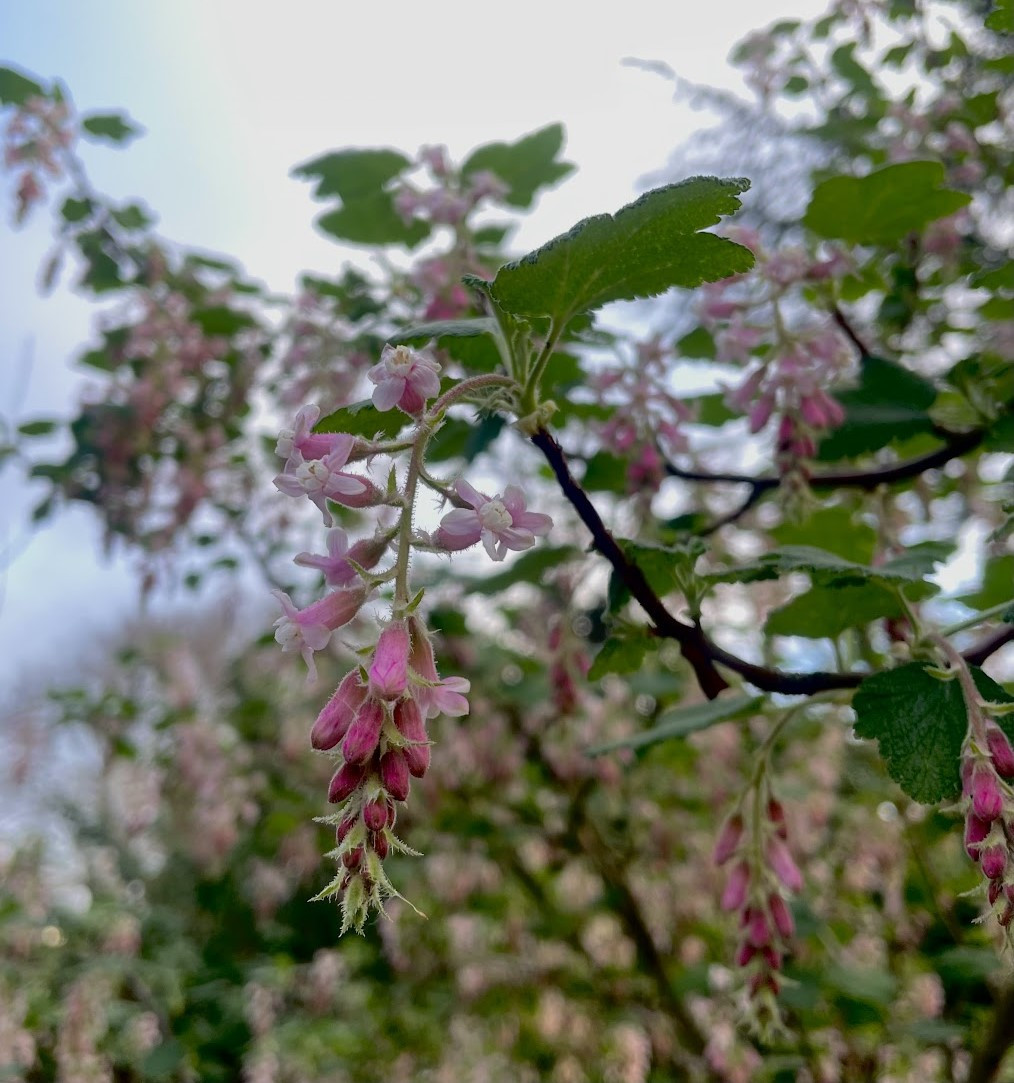
Red-flowering currant stuns with masses of blooms in this coastal Los Angeles native garden.
By Mandy Staal & Sara Saxonberg
Weather and Climate
Devastating fires have left ash in the air and so many lives in ruins. Yet hope prevails. It is beautiful to see Los Angeles come together to support firefighters and those affected. Patience, love and support for the Altadena, Palisades & Castaic communities (and beyond) will be essential for healing and recovery in the coming weeks and years.
In the coming weeks we will be adding fire related resources for landscaping and edible gardening to our resources page of the website, so keep a lookout there for support if you need it. Our dear colleague, Gina Ross, who has cared for many of our clients’ gardens, and supported so much of our marketing and behind the scenes operations has experienced this devastation first hand. She lost her home and home based apothecary business in the early hours of the Eaton fire. To help support her as she rebuilds her life, restores her tool kit, work wardrobe, and so much more, you can donate to her directly via her GoFundMe link.
While sufficient words in this time feel out of reach, we are grateful for the greater gardening community and the healing powers the earth always provides. Pachamama Inspired is committed to leading local regenerative gardening efforts forward through educating our clients and dissemination of accurate resources. By raising awareness of topics explained through voices of experts in the field who have spent their careers researching these difficult challenges ahead, we feel positive that we can play a role to reverberate positive change.
Blooms, Color, and Pollinators
Pollinator-friendly garden design in San Pedro, Long Beach, Torrance and Palos Verdes
On a happier note, we have just received our first significant rain which is a sign of rebirth as February in California ushers in the first signs of spring. Though it seems like the winter dormant plants just starting resting, they are already awakening to the longer days and warming soil. The hills are lush and green with new sprouts. Flower buds are forming and some are already opening. We love seeing the baby leaves, some bright green and soft, some covered with fluff, emerging from smooth, bare branches. Hopefully, we will see some more rain this month so we can have a resilient spring and lower fire danger.
This month we enjoy the early native bloomers and the buds starting to open on some of our edibles:
- Ray Hartman ceanothus (Ceanothus ‘Ray Hartman’)
- Yankee Point ceanothus (Ceanothus griseus horizontalis ‘Yankee Point’)
- red-flowering currant (Ribes sanguineum)
- gooseberry (Ribes speciosum)
- Manzanita (Arctostaphylos spp.)
- western columbine (Aquilegia formosa)
- baby blue eyes (Nemophila menziesii)
- lemonade berry (Rhus integrifolia)
- sugarbush (Rhus ovata)
- bladderpod (Peritoma arborea)
- hummingbird sage (Salvia spathecea)
- silver lupine (Lupinus albifrons var. albifrons)
- bush sunflower (Encelia californica)
- blueberries (Vaccinium spp.)
- peaches (Prunus persica)
- plums (Prunus domestica)
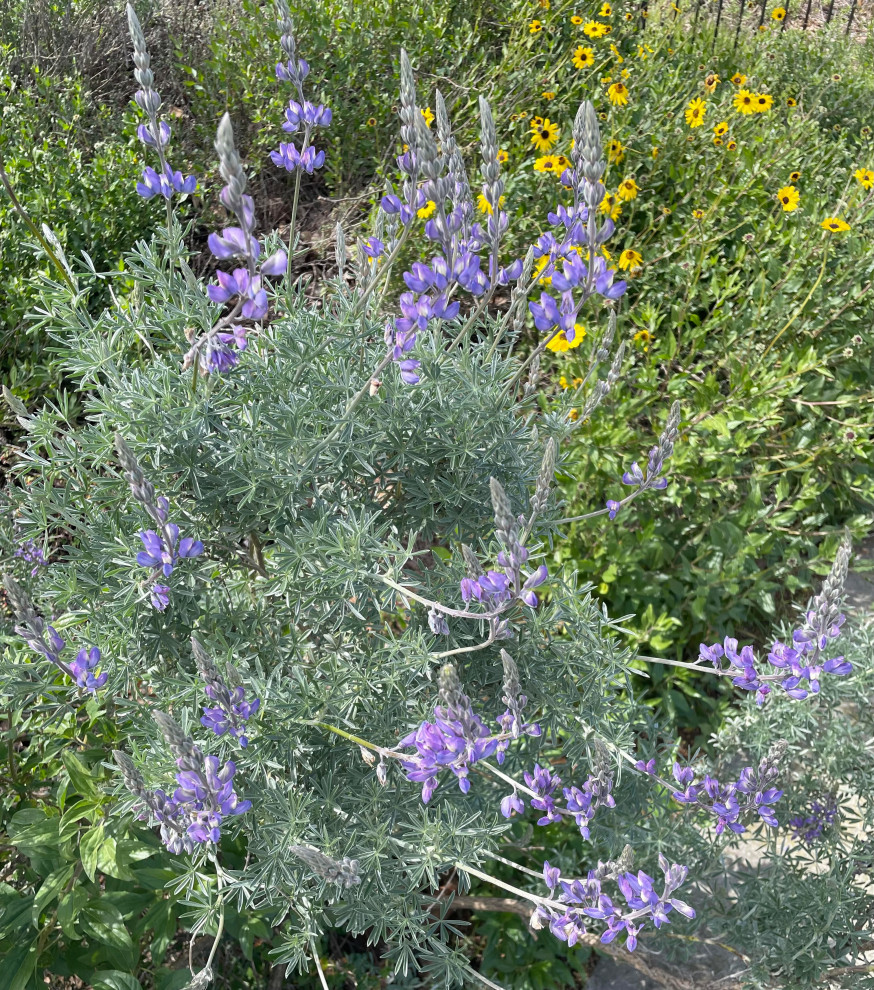
In this California native garden, an early blooming silver lupine shines with bush sunflower.
Harvests
Edible gardens in San Pedro, Long Beach, Torrance and Palos Verdes
These plants may be ready for harvest in your garden depending on when you planted:
- peas
- broccoli
- cauliflower
- cabbage
- brussel sprouts
- kohlrabi
- lettuce
- chard
- spinach
- carrots
- strawberries
- parsley
- cilantro
- avocados
- citrus
Planting
California native plant gardens in San Pedro, Long Beach, Torrance and Palos Verdes
This month is your last best opportunity to sow spring wildflowers! You can also plant or sow these:
- parsley
- cilantro
- green onions
- artichoke
- asparagus
- peas
- carrots
- lettuce
- beets
- chard kale turnip mustard collards
- it is the last month to plant brassicas like broccoli, cabbage, cauliflower
- bareroot fruit trees and vines
- propagate and transplant plants like your strawberry runners
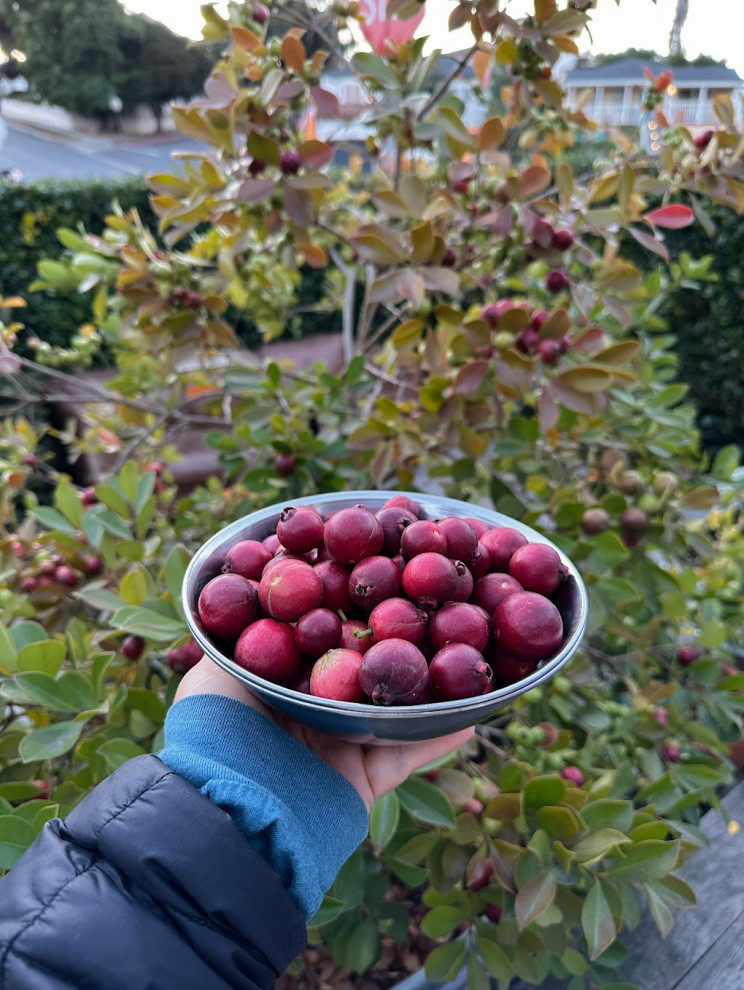
Strawberry guava harvests are abundant in an organic edible garden in San Pedro.
Watering
Waterwise garden design San Pedro, Long Beach,Torrance and Palos Verdes
This is a good time to check if your irrigation system needs any fixing.
- Set your irrigation to manual once the rain starts so precious water is not wasted.
- In an established native garden (1 year or older), there’s no need for supplemental irrigation if it has rained more than 1.5” that month.
- Here in San Pedro, we got around 1.5” of rain depending on where you are located. One way to check how much rain you got is to put out a few measuring cups in a few areas of the yard and calculate the average rain captured in each cup. You can always supplement with a shorter irrigation run the day after a rain event to ensure the water is really soaking the plants well and take full advantage of the rains we received. This will reset your rain clock back another two weeks to a month depending on how established your plants are and what's growing.
- Fruit trees appreciate a deep soak every two weeks depending on your soil and how much fruit is on the tree.
- Raised beds and pots with new plantings prefer water every other day. Those with more established plants prefer water twice a week. The key here is keeping the soil moist at the level where the roots are growing during establishment and then just barely allowing it to dry out between waterings to push water savings, but not dry out so much that soil moisture level will need to be fully reestablished.
Keep in mind these estimates are highly variable according to plant needs, soil, sun, wind, etc. If you are in doubt about your watering schedule and amount, check the soil moisture at least 4 inches deep for trees and shrubs and 2 inches deep for annuals.
Pruning
Permaculture garden design San Pedro, Long Beach,Torrance and Palos Verdes
It is still a good time to prune deciduous trees and shrubs
- Prune your dormant fruit trees and vines once their leaves have dropped. Remove dead wood, crossed and crowded branches, and open the structure of the canopy to allow airflow and more sun exposure. Remove watersprouts, the vertical shoots coming from the bottom of the trunk. If you want to maintain the tree size, reduce the overall height or width of the tree by no more than a third. Here are some resources for more information on this complex topic: Greg Alder’s Advice and a video of Tom Spellman’s pruning methods.
- Skip the prune sealer. Prune sealer can trap moisture and cause rotting. Healthy trees have their own immune systems that are more effective at protecting themselves from infection without the side effects. Allow your prune cuts to scab over on their own.
- Contrary to popular belief, you can skip the dormant spray. Leaf curl may look horrifying but it doesn’t hurt your trees or affect fruit production. Again, healthy trees have a very effective immune system that will fight infections for you. They will eventually drop infected leaves. For more information related to dormant sprays and disease prevention we recommend reading this article by Greg Alder.
- Make sure you sanitize pruners with alcohol between different plants to prevent spreading diseases.
- Prune your natives like coyote bush, except for winter or early spring bloomers like ceanothus and manzanita.
- Cut back milkweed, daisies, lavender and other perennials if you haven’t already
- Cut back roses. Many resources tell you to prune roses in the spring which is true for areas with colder winters, but in Southern California and the Palos Verdes Peninsula the best time to prune roses is during the winter, either February or March. See this UC master gardener article for a comprehensive guide.
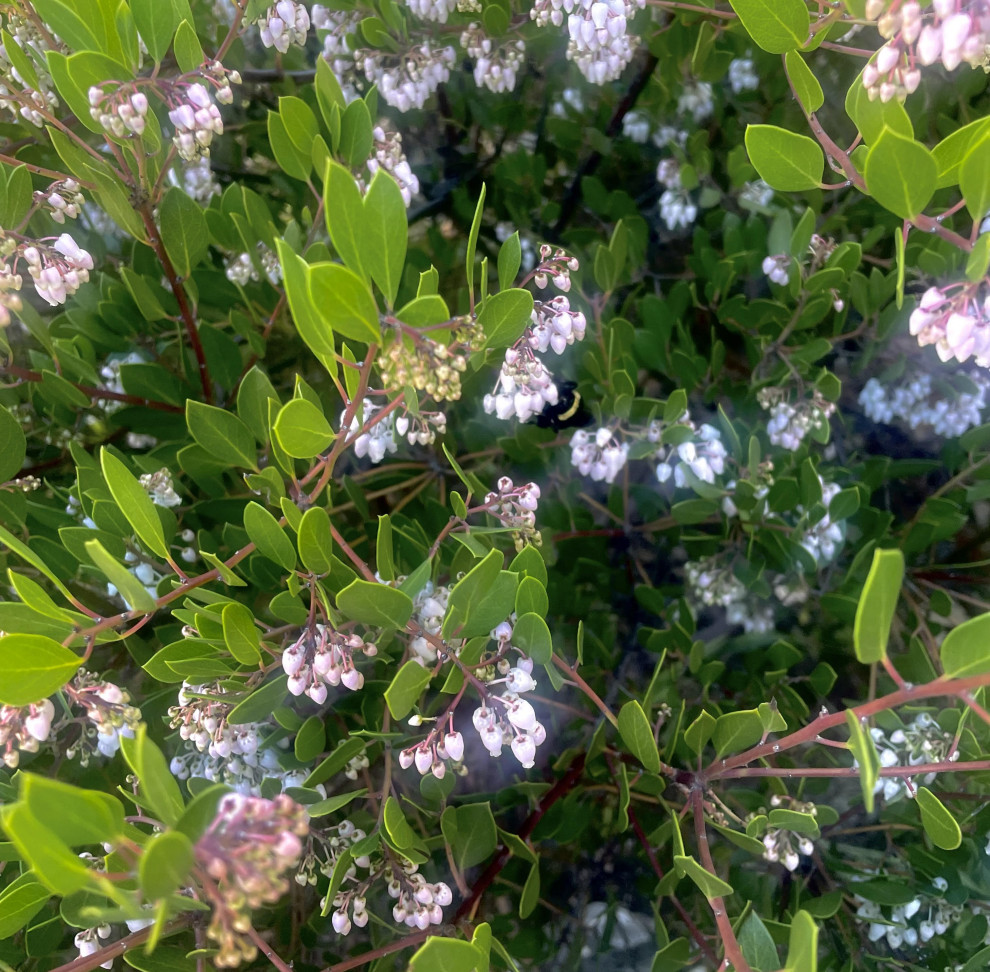
Light pink blooms on this manzanita are a highlight in this waterwise Torrance garden.
Mulching, Compost, and Fertilizing
Organic garden design San Pedro, Long Beach, Torrance and Palos Verdes
- Add compost and mulch if you haven’t already to improve soil quality. It will start breaking down nicely with the rain. These organic materials feed soil organisms like earthworms and fungi which then help feed plants. You may even get some cute mushrooms sprouting up post-rain!
- Add compost or organic fertilizer to citrus and avocados, especially those in pots. Greg Alder has some great articles on growing fruit trees and using mulch or compost instead of fertilizer.
- Make sure the crown (where the trunk meets soil and tapers) of trees and shrubs is not buried in mulch or compost as this can cause rot.
- If you are not living in a fire prone area, consider leaving the leaves but be aware of leaf accumulation near structures and be sure to keep your house and neighbors safe by composting the leaves or using them as mulch in areas where fires are not a concern.
- Remember to keep mulch a few inches away from the trunk of trees and shrubs. It can cause crown rot.
- Don’t dig or stomp on soil until about 3 days after rain to avoid compaction.
Pests and Diseases
Sustainable garden design San Pedro, Long Beach, Torrance and Palos Verdes
- The weeds are emerging in masses with the warming soil. It's best to remove weeds before they produce seeds.
- Snails, slugs, and earwigs are out and about this month
- Ants may be farming honeydew on your plants if you have an infestation of aphids, scale, or mealybug. They defend these bugs from predators in exchange so the beneficial insects can’t do their job. Check out this website from UC IPM for an exhaustive list of ant related pest problems (and an all garden pest database)
- Keep in mind it is usually best to avoid sprays because they almost always hurt beneficial insects who are more than willing to do the work for you. Create an ecosystem that attracts the predators of the pest you are dealing with for a more long term solution.
- Gophers are still tunneling around so protect your new plantings with gopher cages
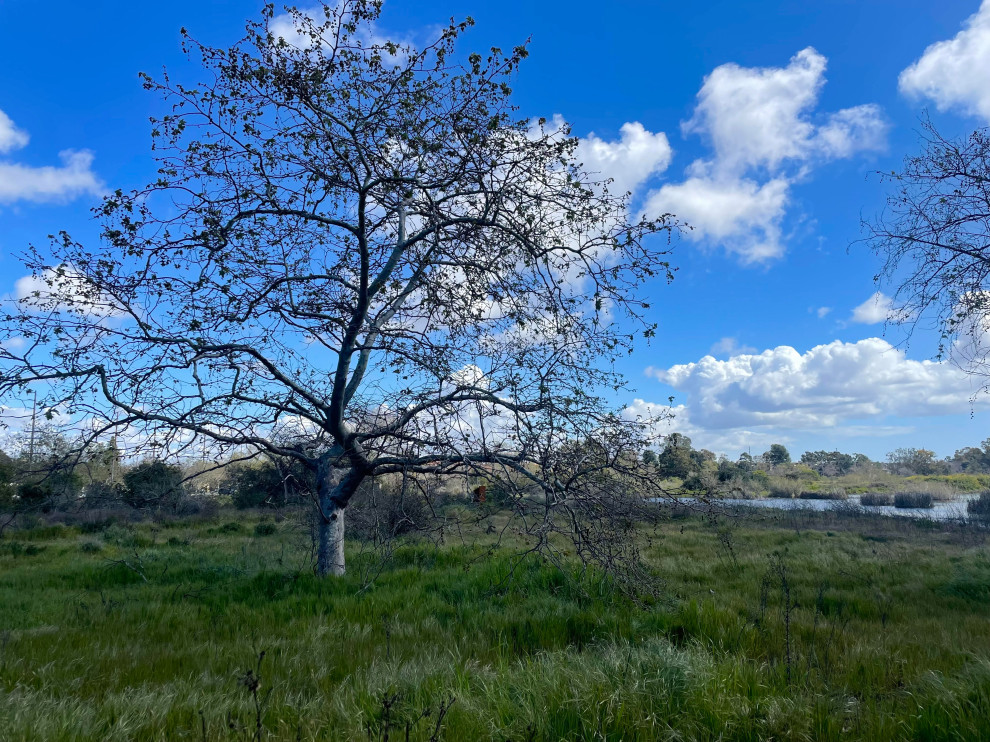
A statuesque sycamore stands amongst fresh green grasses at Madrona Marsh.
Gratitude
We are so thankful for the hardworking firefighters that put their lives in danger and for all the generous volunteers who quickly assembled to take care of our city. Thanks to them, the communities can begin to restart their lives as well with the help, care, and donations of those who are able.
Nature is resilient and as a part of nature, so are humans. There are few sights more beautiful that natural spaces rebirthing with wildflowers, some of which have lain dormant for years waiting for this moment to pop up for their turn to transform burned hill sides into shades of green, purple, and orange. The manzanitas and oaks will sprout anew amongst their blackened branches. Our community will come together with local conservancies to volunteer their labor in an effort to ensure invasive plants don’t take back over. Together we will continue to co-create habitat in the city for both people and for our smaller, wilder neighbors. We will grow and learn better methods of fire safety and resistance and adapt to be more resilient. The people of Los Angeles can move forward taking care of the land and their neighbors.
In times like these, we feel called to help in the ways we are gifted. At Pachamama Inspired, we are committed to supporting our community with focusing on fire safe landscaping and supporting our community as needed. A heartfelt thank you to all of our clients and readers who have supported the recovery efforts and donated to relief. Together we will get through this challenging time.
With gratitude and hope,
Sara, Mandy & the Pachamama Team
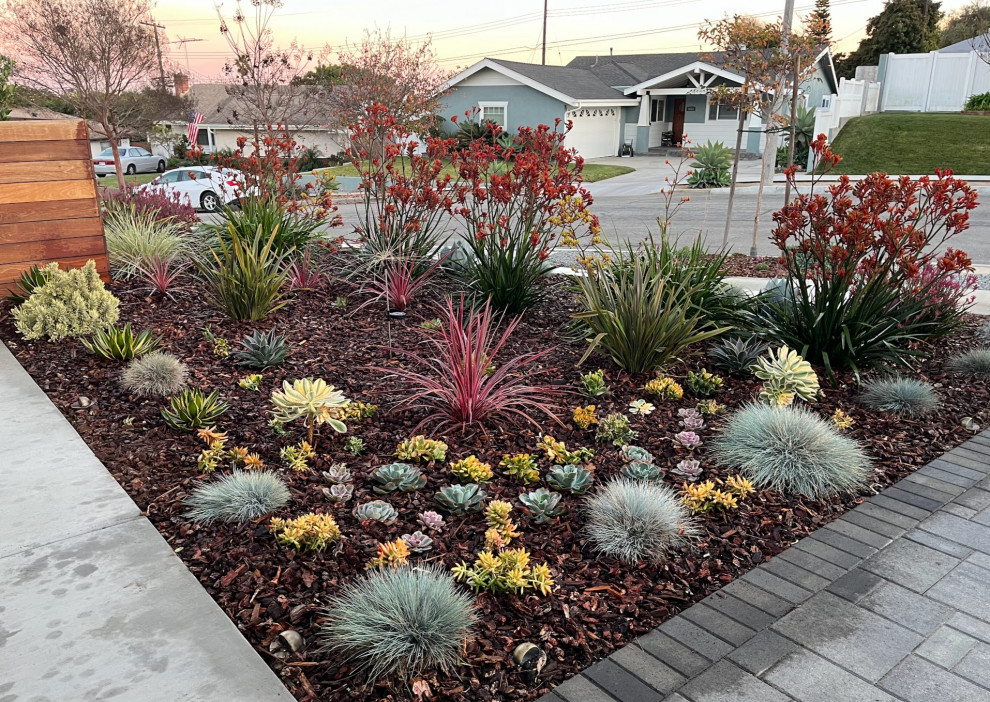
This waterwise garden of succulents, kangaroo paw, cordyline, and more mimic the colors of the sunset in Torrance.
References:
“California Native Gardening: A Month by Month Guide” by Helen Popper
“Southern California Gardening A Month by Month Guide” by Pat Welsh
